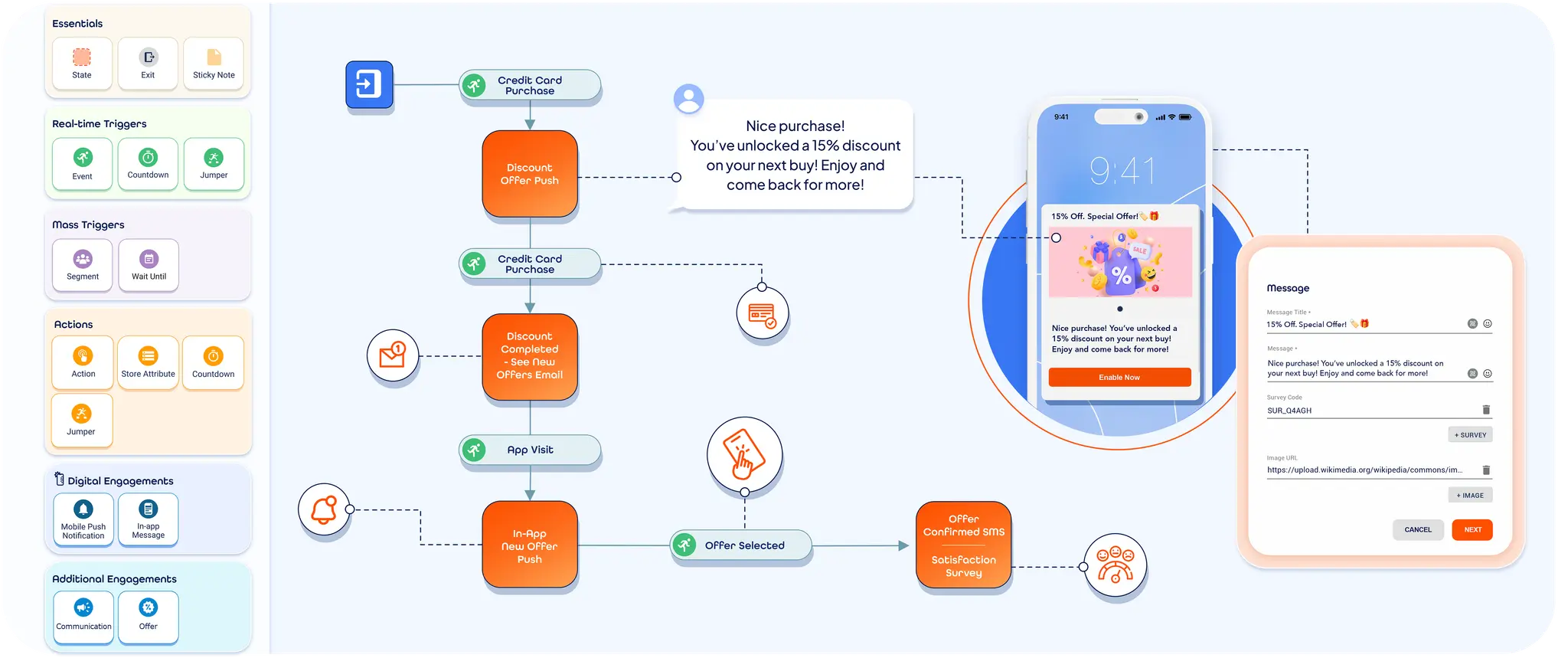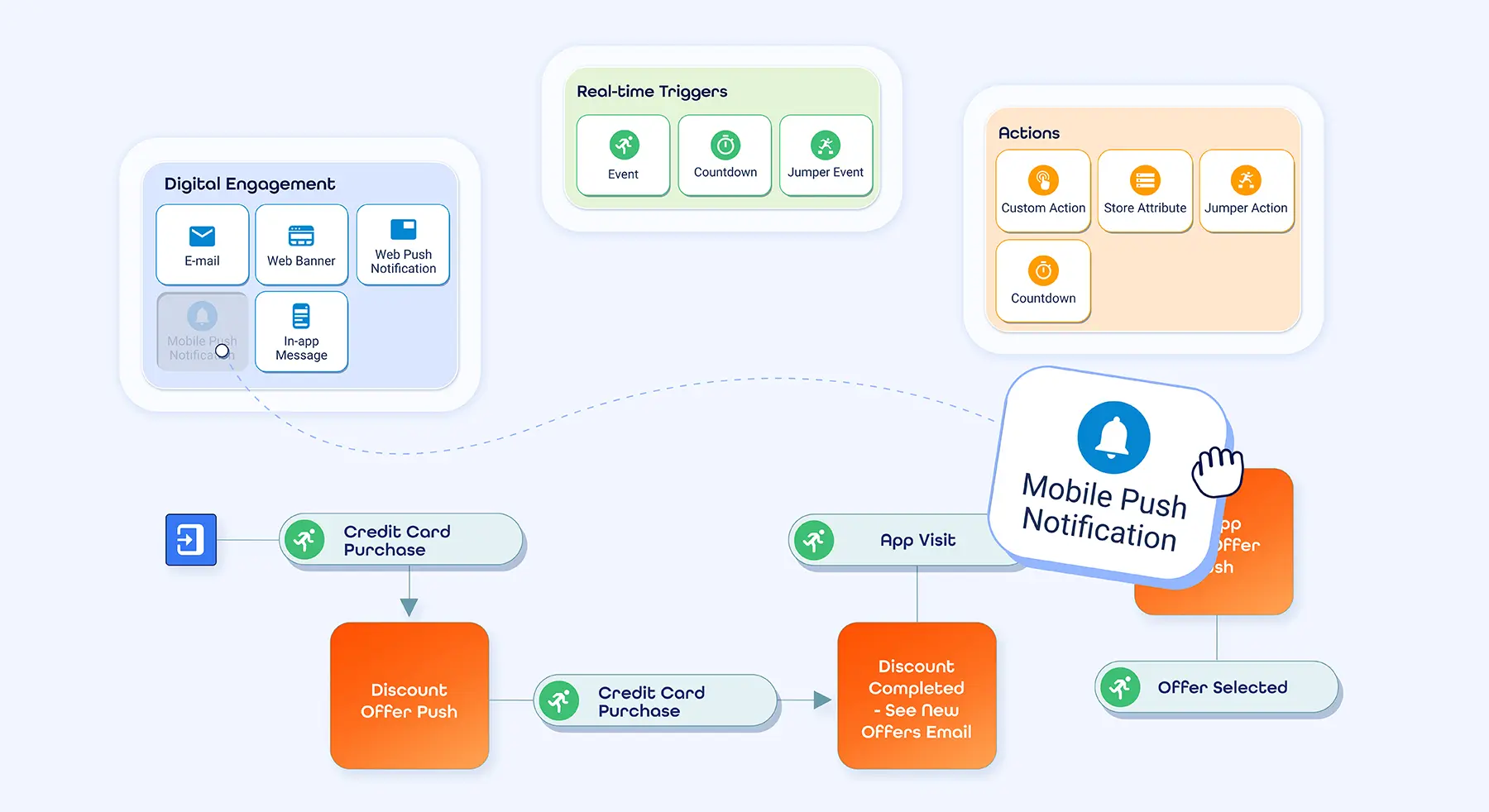Customer Journey Map
What is a Customer Journey Map?
A customer journey map is a visual representation illustrating the various steps customers take when engaging with a company, encompassing products, online experiences, retail encounters, services, or any combination thereof.
The complexity of such a map increases with the number of touchpoints involved, but it’s essential for understanding customer interactions thoroughly.
A journey map provides a static view of the customer experience, while journey orchestration transforms that map into a living, real-time system that adapts and reacts to customer behavior instantly.
From Mapping to Orchestration
While mapping shows what happens, journey orchestration determines what to do next.
It connects data, decisions, and delivery to create seamless, personalized customer experiences.
evamX enables businesses to go beyond traditional mapping by orchestrating dynamic, AI-driven journeys that respond to live signals clicks, logins, purchases, or inactivity the moment they occur.
This means customers receive the right message, on the right channel, at the right time.

Why is Customer Journey Mapping Important?
Customer journey mapping is a powerful tool that helps businesses visualize and understand customer experiences as their users interact with their brand, from the first point of contact through to purchase and beyond. Below are five key benefits, now enhanced with orchestration insight:
1. Improved Customer Understanding
Mapping reveals the full experience from the customer’s perspective — website visits, emails, service calls, and social media interactions.
When paired with Evam’s Journey Designer, these insights can be instantly transformed into real-time journeys, ensuring that learnings translate directly into engagement.
2. Identifying Pain Points
A clear map highlights friction — confusing checkout steps, slow support, or unresponsive channels.
Journey orchestration resolves these issues dynamically by triggering real-time corrective actions such as follow-up messages, alerts, or alternative paths.
3. Enhanced Personalization
Mapping allows segmentation, but orchestration makes personalization actionable.
evamX’s NBX Decisioning Engine and Evo AI evaluate customer data in real time, choosing the next-best message, offer, or channel for each user — at scale.
4. Consistency Across Channels
An omnichannel journey map ensures unified messaging.
evamX elevates this further by orchestrating push notifications, emails, in-app messages, IVR, and chatbots from a single platform guaranteeing brand consistency and timing accuracy.
5. Increased Customer Retention and Loyalty
When brands use orchestration to deliver timely, contextual experiences, customers feel recognized and valued.
evamX automates follow-ups, reminders, and offers that nurture long-term relationships and drive loyalty.
How to Craft a Customer Journey Map?
In order to create an effective customer journey map, businesses should follow these steps:
1. Define Goals: Set clear objectives: improve satisfaction, identify friction, or boost conversions.
With orchestration in mind, align goals with measurable engagement outcomes — such as trigger-based conversions or reduced drop-off rates.
2. Segment Customers: Divide your audience into personas based on behavior, demographics, or lifecycle stage.
evamX uses AI-driven segmentation that updates in real time as customer behavior changes.
3. Map the Touchpoints: Identify every interaction — online or offline — and how they connect.
Evam’s event catalogue captures 50+ mobile and web events (clicks, app usage, location, push opens) that feed orchestration logic automatically.
4. Plot Each Stage: Outline stages such as awareness, consideration, purchase, and retention.
Journey Designer lets you visually represent these phases through drag-and-drop nodes connected by triggers and timers.
5. Visualize the Experiences: Turn insights into an interactive map or flow. With evamX, you can simulate and test the journey before launch, ensuring each condition and rule behaves as intended.
6. Identify New Opportunities: Spot cross-sell, upsell, or recovery moments (like cart abandonment or KYC expiry).
Evam’s orchestration engine can automatically launch contextual offers and nudges during these micro-moments.
7. Collaborate Across Teams: Marketing, product, and data teams can co-create and monitor journeys in real time through a shared interface — removing silos between departments.
8. Implement Changes: Use insights to adjust campaigns and flows dynamically.
Evo AI provides recommendations to improve message timing, engagement rates, and channel performance.
9. Keep it Current: Customer behavior evolves — your journeys should too.
evamX’s real-time event engine ensures journeys update automatically as customer data and actions change.
evamX: Dynamic Customer Journey Mapping for Seamless Experiences
evamX is a real-time customer engagement platform that brings maps to life.
Its modules — such as Journey Designer, NBX, and Evo AI empower marketers to orchestrate, test, and optimize personalized journeys without coding or IT dependency.

A retail customer journey map looks very different from an insurance one.
evamX builds industry-specific, contextual journeys for every sector banking, telecom, retail, travel adapting to unique customer behaviors and needs.
Key Capabilities:
- AI-powered segmentation & decisioning
- Real-time orchestration across channels
- Frequency & timing controls (Proper Time, Silent Period)
- Visual, drag-and-drop journey creation
- Predictive insights & optimization through EVO AI
ABB Bank increased upsell rates by 150% and reduced call center costs by 50% through real-time journey orchestration powered by evamX.
Watch It in Action
🎥 Watch the Journey Orchestration Demo
See how Evam turns customer signals into meaningful, personalized actions across every channel instantly.
Join the Evam Community
Subscribe to receive the latest insights, news, and updates straight to your inbox.


